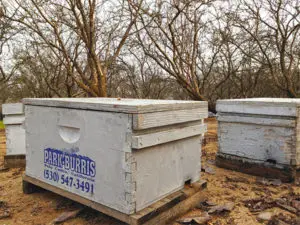Almond Tree Life Cycle | Almond Tree Farming

To grow almond trees is to witness the beauty of nature’s process.
Ever wondered where almonds come from? The almond is the product of an almond tree, and a high percentage of almond tree farming takes place in California.
In fact, most wholesale almonds all over the world come from California almond growers. Almond farmers grow almonds trees all year and harvest almonds between August and October.
Almonds are heavily dependent on water. It takes approximately 1 gallon of water just to produce one almond.
The best conditions for almond tree farming are climates conducive to a particular winter chilling, which limits almond tree farming to a few regions in the world. Outside of California, you will also find almond farmers in Spain, Italy, Australia, Greece. Morocco, Turkey, and Portugal. California almonds are equal to 75% of the entire world’s wholesale almond production and 100% of the supply of the U.S.
There are four phases that take place in the almond tree farming process:
ALMOND TREES FROM BUD TO BLOOM
From the months, November to February, the almond tree farming process includes buds that need to go through cold weather and can be negatively impacted by a heavy frost. In late February and early March, the almond tree begins to produce blossoms that are ready for pollination.
Since there are different varietals, the time frame of when blooms occur can vary. Climate variation is considered one of the most critical phases in growing almond trees since it can profoundly impact the harvest size.

ALMOND BLOOM POLLINATION
The second phase of almond tree farming is pollination. Once the almond tree has blossomed, it is time for pollination. The most efficient way to accomplish this is with the help of bees. The weather once again plays an important role here since bees do their best work in sunny, warm and calm conditions. Just like most farming, almond tree farming is significantly affected by the weather and so are the bees that help pollinate the growing almond trees.
ALMOND MATURING AND HULL-SPLIT
From March to June the almond tree begins to transform the blossoms into an almond in their hull. It’s a very special time for almond growers since the almonds are developing in the shell. By July and August, the hull begins to split slightly open to allow for the almond shell to start drying. Over time just as a flower would bloom, the hull continues to break open wider while the hull itself becomes tougher and leathery while still adhering to the almond. When growing almond trees, each phase of its process needs to happen in divine time for to harvest the most almonds for the almond farmer’s success.

ALMOND MATURING AND HULL-SPLIT
From March to June the almond tree begins to transform the blossoms into an almond in their hull. It’s a very special time for almond growers since the almonds are developing in the shell. By July and August, the hull begins to split slightly open to allow for the almond shell to start drying. Over time just as a flower would bloom, the hull continues to break open wider while the hull itself becomes tougher and leathery while still adhering to the almond. When growing almond trees, each phase of its process needs to happen in divine time for to harvest the most almonds for the almond farmer’s success.
THE ALMOND FARMER’S ROLE
Although the four stages of the almond tree farming process are mostly an act of nature, the almond farmers play an enormous role in making taking the almond from farm to the consumer. This potentially labor-intensive process becomes an orchestrated production to satisfy the large demand for these highly nutritious nuts that are consumed all around the world.
California almonds are the most frequent source of wholesale almonds on the market, and California has the highest number of almond growers, almond farmers and growing almond trees. Natures Eats sources almonds from high quality almond growers in this region.
Written by Lisa Saremi
